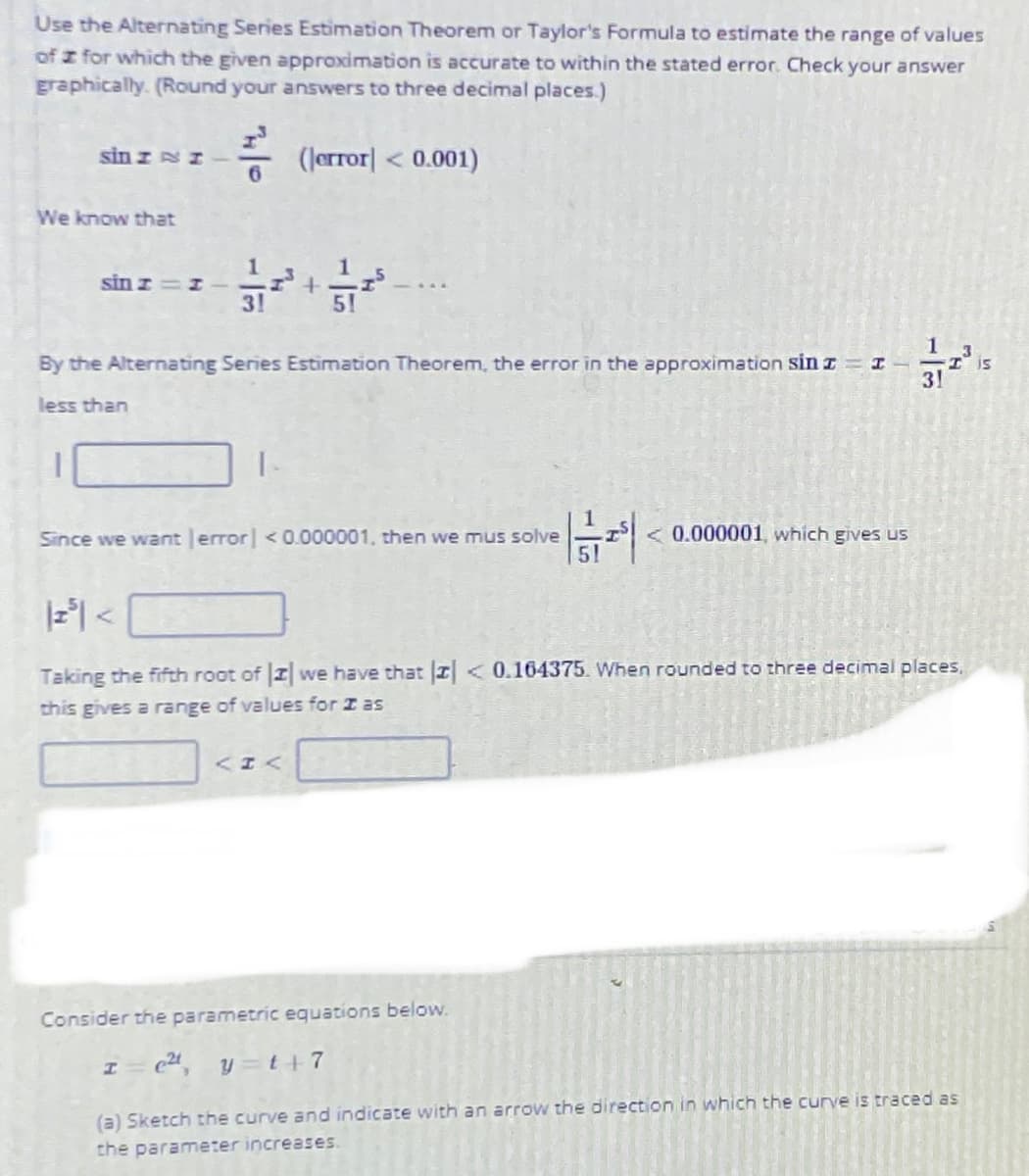Consider the parametric equations below. I= 4, y =t+7 (a) Sketch the curve and indicate with an arrow the direction in which the curve is traced as the parameter increases.
Consider the parametric equations below. I= 4, y =t+7 (a) Sketch the curve and indicate with an arrow the direction in which the curve is traced as the parameter increases.
Calculus: Early Transcendentals
8th Edition
ISBN:9781285741550
Author:James Stewart
Publisher:James Stewart
Chapter1: Functions And Models
Section: Chapter Questions
Problem 1RCC: (a) What is a function? What are its domain and range? (b) What is the graph of a function? (c) How...
Related questions
Question
please explain

Transcribed Image Text:Use the Alternating Series Estimation Theorem or Taylor's Formula to estimate the range of values
of z for which the given approximation is accurate to within the stated error. Check your answer
Eraphically. (Round your answers to three decimal places.)
sin z sI
- (Jerror| < 0.001)
We know that
sin z=I
3!
51
By the Alternating Series Estimation Theorem, the error in the approximation sin z = I
31
is
less than
Since we want error <0.000001, then we mus solve
< 0.000001, which gives us
Taking the fifth root of I we have that I<0.164375. When rounded to three decimal places,
this gives a range of values for I as
Consider the parametric equations below.
y =t+7
(a) Sketch the curve and indicate with an arrow the direction in which the curve is traced as
the parameter increases.
Expert Solution
This question has been solved!
Explore an expertly crafted, step-by-step solution for a thorough understanding of key concepts.
This is a popular solution!
Trending now
This is a popular solution!
Step by step
Solved in 2 steps with 2 images

Recommended textbooks for you

Calculus: Early Transcendentals
Calculus
ISBN:
9781285741550
Author:
James Stewart
Publisher:
Cengage Learning

Thomas' Calculus (14th Edition)
Calculus
ISBN:
9780134438986
Author:
Joel R. Hass, Christopher E. Heil, Maurice D. Weir
Publisher:
PEARSON

Calculus: Early Transcendentals (3rd Edition)
Calculus
ISBN:
9780134763644
Author:
William L. Briggs, Lyle Cochran, Bernard Gillett, Eric Schulz
Publisher:
PEARSON

Calculus: Early Transcendentals
Calculus
ISBN:
9781285741550
Author:
James Stewart
Publisher:
Cengage Learning

Thomas' Calculus (14th Edition)
Calculus
ISBN:
9780134438986
Author:
Joel R. Hass, Christopher E. Heil, Maurice D. Weir
Publisher:
PEARSON

Calculus: Early Transcendentals (3rd Edition)
Calculus
ISBN:
9780134763644
Author:
William L. Briggs, Lyle Cochran, Bernard Gillett, Eric Schulz
Publisher:
PEARSON

Calculus: Early Transcendentals
Calculus
ISBN:
9781319050740
Author:
Jon Rogawski, Colin Adams, Robert Franzosa
Publisher:
W. H. Freeman


Calculus: Early Transcendental Functions
Calculus
ISBN:
9781337552516
Author:
Ron Larson, Bruce H. Edwards
Publisher:
Cengage Learning